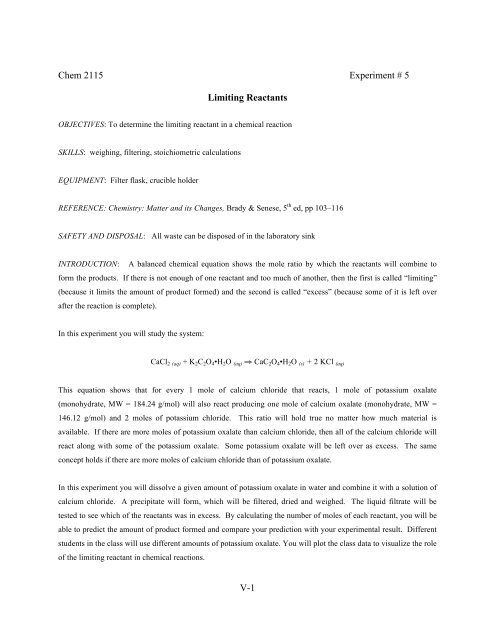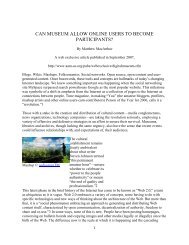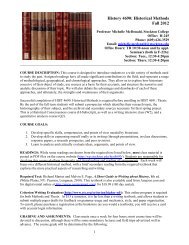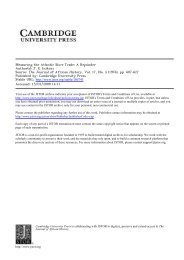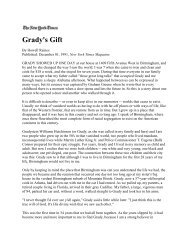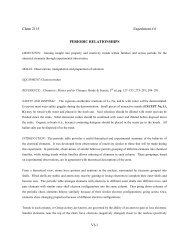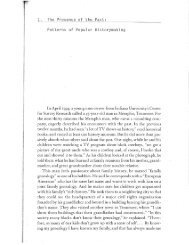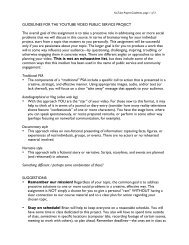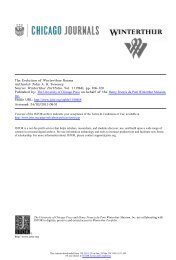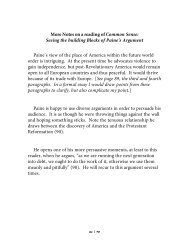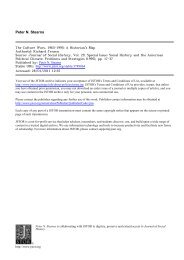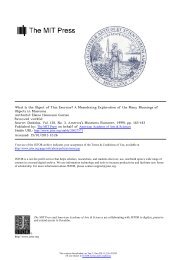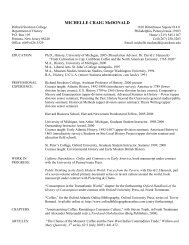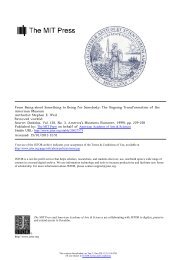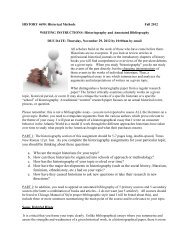V-1 Chem 2115 Experiment # 5 Limiting Reactants
V-1 Chem 2115 Experiment # 5 Limiting Reactants
V-1 Chem 2115 Experiment # 5 Limiting Reactants
Create successful ePaper yourself
Turn your PDF publications into a flip-book with our unique Google optimized e-Paper software.
<strong>Chem</strong> <strong>2115</strong> <strong>Experiment</strong> # 5<br />
<strong>Limiting</strong> <strong>Reactants</strong><br />
OBJECTIVES: To determine the limiting reactant in a chemical reaction<br />
SKILLS: weighing, filtering, stoichiometric calculations<br />
EQUIPMENT: Filter flask, crucible holder<br />
REFERENCE: <strong>Chem</strong>istry: Matter and its Changes, Brady & Senese, 5 th ed, pp 103–116<br />
SAFETY AND DISPOSAL: All waste can be disposed of in the laboratory sink<br />
INTRODUCTION: A balanced chemical equation shows the mole ratio by which the reactants will combine to<br />
form the products. If there is not enough of one reactant and too much of another, then the first is called “limiting”<br />
(because it limits the amount of product formed) and the second is called “excess” (because some of it is left over<br />
after the reaction is complete).<br />
In this experiment you will study the system:<br />
CaCl2 (aq) + K2C2O4•H2O (aq) ⇒ CaC2O4•H2O (s) + 2 KCl (aq)<br />
This equation shows that for every 1 mole of calcium chloride that reacts, 1 mole of potassium oxalate<br />
(monohydrate, MW = 184.24 g/mol) will also react producing one mole of calcium oxalate (monohydrate, MW =<br />
146.12 g/mol) and 2 moles of potassium chloride. This ratio will hold true no matter how much material is<br />
available. If there are more moles of potassium oxalate than calcium chloride, then all of the calcium chloride will<br />
react along with some of the potassium oxalate. Some potassium oxalate will be left over as excess. The same<br />
concept holds if there are more moles of calcium chloride than of potassium oxalate.<br />
In this experiment you will dissolve a given amount of potassium oxalate in water and combine it with a solution of<br />
calcium chloride. A precipitate will form, which will be filtered, dried and weighed. The liquid filtrate will be<br />
tested to see which of the reactants was in excess. By calculating the number of moles of each reactant, you will be<br />
able to predict the amount of product formed and compare your prediction with your experimental result. Different<br />
students in the class will use different amounts of potassium oxalate. You will plot the class data to visualize the role<br />
of the limiting reactant in chemical reactions.<br />
V-1
EXPERIMENTAL PROCEDURES<br />
1. Reaction: Obtain approximately 50 mL of distilled water in a 125 mL Erlenmeyer flask. Adjust the pH of the<br />
water by adding 3 M NH3 dropwise until the litmus or pH paper shows that the solution is just basic. To test, obtain<br />
a piece of either red/neutral litmus or pH paper. Using a stirring rod, touch a drop of the distilled water to the paper.<br />
If the paper turns blue, the solution is already basic. If the paper stays red, add 1-3 drops of the 3 M NH3, stir and<br />
check the color of the paper. Continue this until the solutions turns the paper blue.<br />
Your instructor will assign you a mass of potassium oxalate. Weigh out the assigned mass of potassium oxalate to<br />
within + 0.005 g of your assigned mass. Dissolve the potassium oxalate in the 50 ml of the pH adjusted distilled<br />
water. Use a small quantity of distilled water to rinse the weighing boat into the beaker in order to transfer ALL of<br />
the potassium oxalate. Next, while stirring, use a volumetric pipette to carefully add 15 mL of the 0.0750 M<br />
calcium chloride solution to your flask to form the calcium oxalate precipitate. Note your observations.<br />
Using a hot plate, gently heat the solution to 75°C for 15 minutes. Do not let the temperature go over 75°C. When<br />
removing your thermometer from the flask, be sure to wash it carefully with distilled water into the flask in order to<br />
limit the amount of precipitate lost. After 15 minutes, remove the solution from the heat and allow the precipitate to<br />
settle. You can immerse the beaker in an ice bath to help cool the mixture. While the precipitate is settling, warm<br />
approximately 30 mL of distilled water to 70–80°C. This warm water will be used later to wash the filtered<br />
precipitate.<br />
2. Filtering: Prepare to filter the calcium oxalate precipitate by locating your fritted (Gooch) crucible and obtaining<br />
a crucible holder, filter paper/pad and filtering flask. Place the filter in the crucible and record the mass. Set-up the<br />
filtration apparatus as demonstrated by your laboratory instructor. Apply suction, and slowly pour approximately<br />
10 mL of distilled water through the crucible. Use a stirring rod to help seat the filter in the crucible. Be sure that<br />
the filter covers all of the holes and that it is properly seated onto the crucible so that no solid can pass around the<br />
outside edges of the filter.<br />
While the suction remains on, carefully filter the precipitate by pouring it slowly from the Erlenmeyer flask into the<br />
crucible. Use small portions of distilled water to wash your Erlenmeyer flask to ensure your have transferred all of<br />
the solid to the crucible. Wash the precipitate in the crucible, by slowly adding three 10 mL portions of the warm<br />
distilled water. Allow the suction to pull through the crucible for at least 5 minutes after the last amount of solution<br />
was filtered.<br />
V-2
3. Testing: Break the vacuum at the flask by disconnecting the tubing from the flask while the aspirator is still<br />
running. Obtain two test tubes from your locker. Fill each tube half way using the filtrate from the filtering flask.<br />
Test the filtrate to determine the excess reagent using the following instructions:<br />
Testing for the excess reactant: Test the solutions in test tube 1 and test tube 2 as follows:<br />
Testing for excess CaCl2: Add 2 drops of 0.50 M potassium oxalate to the solution in test tube 1. If a precipitate<br />
forms calcium chloride is in excess and potassium oxalate is the limiting reactant.<br />
Testing for excess K2C2O4 : Add 2 drops of 0.50 M calcium chloride to the solution in test tube 2. If a precipitate<br />
forms, potassium oxalate is in excess and CaCl2 is the limiting reactant.<br />
4. Drying and weighing: Place the crucible in your locker on top of some paper towels and allow the solid to dry<br />
until the next lab period. When you return the following week, determine the weight of your crucible with<br />
your filter and precipitate. Record this mass in your notebook and be sure to enter your results on the lab<br />
computer as well.<br />
NOTEBOOK TEMPLATE INFORMATION<br />
The following experimental data should appear in your lab notebook:<br />
Assigned mass of potassium oxalate and actual mass of potassium oxalate used<br />
Concentration and volume of the calcium chloride solution used<br />
Mass of crucible with filter<br />
Mass of crucible with filter and precipitate<br />
In addition, your lab notebook should contain observations of what you saw and what happened.<br />
As part of the calculations for this experiment, you will need to determine the following quantities:<br />
the number of moles of potassium oxalate that you used.<br />
the number of moles of calcium chloride that you used.<br />
the mass and the number of moles of calcium oxalate precipitate that you recovered<br />
V-3


